BBVA makes headway toward its decarbonization targets in key industries and cuts its emissions by 24 percent in the oil and gas sector
BBVA closed 2023 reporting good progress in decarbonizing its credit portfolio. Improvements in plan delivery reached 24 percent in key sectors —such as oil and gas— for which 2030 targets were set. As of December 2023, 80% of the finance portfolio in high-emission sectors relates to clients actively managing their transition, according to the latest TCFD report published by the bank.
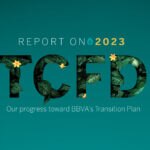
BBVA disclosed the state of progress of its transition plan in its fifth report presented in accordance with the Task Force on Climate Financial Disclosures (TCFD) framework. The report covers improvements in the governance model, strategy, risk management and climate change metrics.
“Our goal is to be net zero in carbon emissions by 2050. This includes both our own emissions and our borrowers' emissions. To achieve this, we established a roadmap and set interim targets for reducing financed emissions by 2030 for several sectors: oil and gas, power generation, automobiles, steel, cement and coal. In 2023 we broadened these targets to two additional sectors, aviation and shipping. We will continue to work on expanding the targets to other industries, in line with the framework of the Net Zero Banking Alliance," said BBVA Chair Carlos Torres Vila in his introduction to the TCFD report.
Progress of transition and alignment plans
Details are given below on the progress of industry alignment plans and clients' transition plans for all those industries for which BBVA has set a target. Fulfillment of these goals is not expected to be a linear process over the short term.

Oil and gas
Absolute financed emissions in the oil and gas sector decreased by 24 percent compared to the 2021 baseline year due to proactive portfolio management and a prioritization of clients actively managing their transition. These clients currently account for 61 percent of the total upstream finance portfolio.
"BBVA will support customers in their transition to alternative forms of low-carbon energy generation by financing investments that facilitate their diversification and decarbonization," the report said.
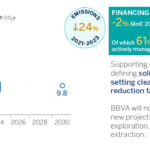
Power generation
The carbon emissions intensity of the power generation portfolio fell by 24 percent compared to the 2020 baseline year.
The reduction observed in 2023 stemmed from a notable 34 percent increase in renewable energy project, improvements in the portfolio mix, influenced by enhanced customer emissions intensities, and proactive portfolio management strategies. This played a pivotal role in fostering growth, particularly among clients actively managing their transition, who now represent 86 percent of the total finance portfolio related to power generation.
Encouraging growth with advanced clients through proactive portfolio management has enabled us to achieve improvements in emissions intensity. Simultaneously, this approach has led to a 12 percent increase in the finance portfolio.
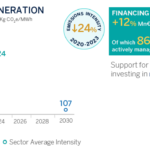
Auto
The carbon emissions intensity of the automobile portfolio fell by 16 percent compared to the 2020 baseline year. The variations primarily stemmed from the transition efforts of clients within the portfolio. This involved a progressive increase in the adoption of electric vehicles across diverse markets. Moreover, there was a notable emphasis on clients actively managing their energy transition.
BBVA aims to finance new clients engaged in pure electric production lines. Additionally, it supports investments to expedite the adoption of electric and plug-in hybrid vehicles, battery manufacturing, and the development of charging infrastructure fueled by renewable energy sources.
Clients actively managing their transition represent 100 percent of the total amount of the bank's auto manufacturing-related finance portfolio.
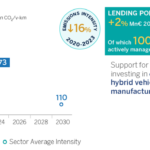
Steel
The carbon emissions intensity of the steel portfolio fell by 7 percent compared to the 2020 baseline year. The steel portfolio outperformed the market in this respect due to the weight of electric arc furnace finance, which is far less carbon-intensive than blast furnaces. BBVA supports the transition to new modes of production, and a higher proportion of recycled materials for decarbonization of the steel industry.
Clients actively managing their transition represent 76 percent of the total amount of the bank's auto steel-related finance portfolio.
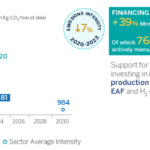
Cement
The carbon emissions intensity of the cement portfolio rose by 2 percent compared to the 2020 baseline year. The increase is explained by improvements in data quality and the addition of a new database for client emissions. This has led to higher intensity data for the entire portfolio.
The bank's business strategy has been selective, relying on clients' own progression as they step up the decarbonization ladder to further advance their transition.
Clients actively managing their transition represent 83 percent of the total amount of the bank's cement-related finance portfolio.
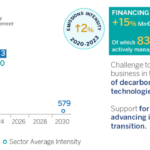
Coal
The coal portfolio has decreased by 9 percent compared to 2022, due to lower exposure to coal-related activities as client finance matures. Close to 85 percent of the finance portfolio in this sector relates to clients who are expected to manage their transition in time to meet the thermal coal target by 2030 in developed countries and by 2040 globally, under the terms of BBVA's Environmental and Social Framework.
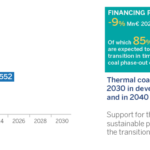
Aviation
The aviation portfolio's emissions intensity is up 1 percent compared to the 2022 baseline year, although it remains below the market average. The change is due to a change in the portfolio mix that is expected to recover over the course of 2024. BBVA continues to work with its clients in designing and executing transition strategies suited to the maturity of this industry.
Clients actively managing their transition account for 87% of the total amount of the airline-related financing portfolio.
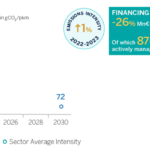
Shipping
BBVA has set itself the goal of falling in line by 2030 with the trajectory set in 2018 by the International Maritime Organization (IMO), and is working hard to switch to ships with decarbonization pathways lower than those established by the IMO. The company supports clients with transition plans aimed at making their fleets more efficient.
To determine the alignment, BBVA has calculated the percentage difference between the intensity of each financed vessel and the decarbonization pathway set by the IMO for that particular type of vessel and for the year 2022.

New sectors with objectives
BBVA is working to establish decarbonization targets for the other CO2-intensive sectors, such as aluminum, commercial and residential real estate, and agriculture, in accordance with the goals and objectives of the NZBA.
As for the strategy being pursued to overcome the risks associated with climate change, “BBVA is working to measure the impact of various climate scenarios —encompassing both transition and physical risks— on its strategy and business,” according to the TCFD report.
These challenges not only carry risks, but they also offer opportunities, which BBVA is well aware of and aims to seize as it looks to position itself amid all the disruption caused by climate change. These opportunities vary by sector and include the electrification of the oil and gas industry, the development of green hydrogen as an alternative energy source, and the refurbishment of buildings and industrial premises to make them more energy efficient and install self-consumption technology, to name but a few.
Low exposure to emission-intensive sectors
As far as the business is concerned, and according to this report “the analysis being carried out and the available results point to a position of resilience, given the relatively low exposure to customers and sectors with higher climate-related risks.” Notably, BBVA’s exposure to emission-intensive and transition risk-sensitive activities represents roughly 5.9% of the Group’s total exposure at December 31, 2023, compared to 6.7% in 2022.
This TCFD report outlines BBVA’s progress towards its transition plan, “following the guidelines and recommendations for financial institutions published by the Glasgow Financial Alliance for Net Zero (GFANZ).”